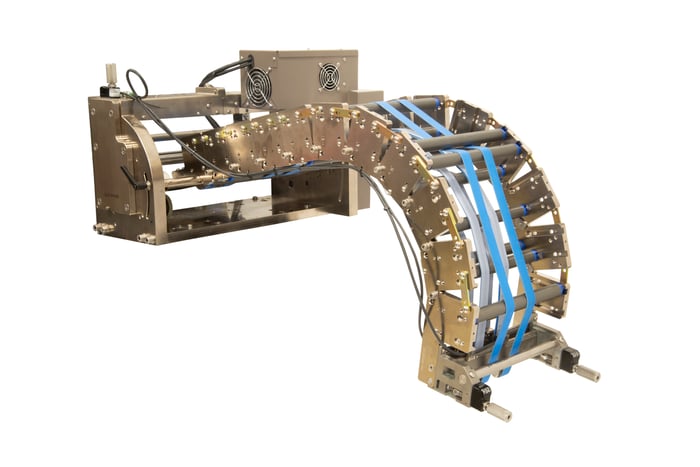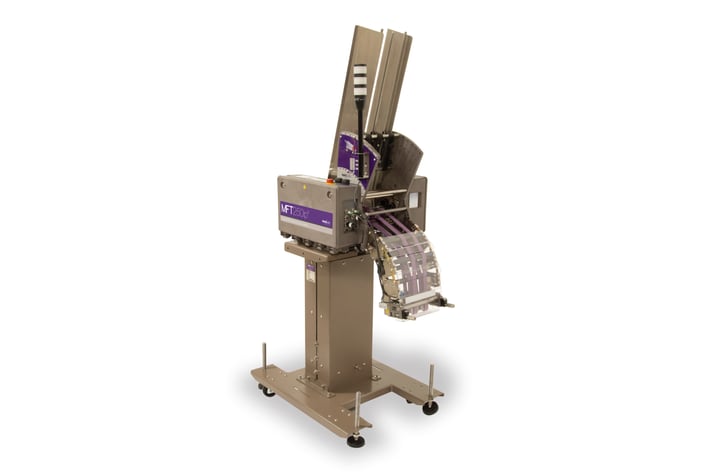Friction Feeders are used in a variety of automation applications ranging from counting and dispensing products to tipping products onto other products. Found in a wide range of industries and applications, Friction Feeders are a common piece of automation equipment that is found in a wide range of industries and applications. They easily integrate into existing production lines and are a powerful piece of standalone equipment.
Friction Feeders use friction between the product and the feed belts to individually separate products from the product stack. The friction feeder's separation mechanism peels the product away from the bottom of the stack and pulls the product through the infeed by natural rubber feed belts. Smart software counts the products as they travel through the discharge section of the machine, and are dispensed and controlled with high-strength belts. Generally, most friction feeders are placed above a transport, such as a lugged or vacuum belt conveyor, and dispense the product onto the surface at a straight or slightly downward angle. But some applications require a different angle.Vertical feeding is a common solution for inserting a product into an opening on the top of various forms of packaging. An open bag, box, or pouch are typical base products in vertical feeding. Vertical feeding is also used in tipping on the front edge of a product like attaching Directions for Use (DFU) on a large bottle.
 Vertical feeding starts with a standard Friction Feeder. MFT Friction Feeders are made of durable carbon composite and have hardened stainless steel shafts. The feeders use a powerful servo motor for precise control over the products as they move through the machine and infeed. Depending on the application requirements the feeder’s discharge is changed to a segmented discharge, known as a Flexible discharge, or a Flexible Driven Discharge is added just downstream of the feeder’s standard discharge. The MFT Flexible Discharge Friction Feeder combines the powerful and robust capabilities of our Friction Feeders with the versatility and adaptability of the Flexible Discharge. The Flexible Discharge has a segmented design that allows for the creation of custom angles to best fit the products and application.
Vertical feeding starts with a standard Friction Feeder. MFT Friction Feeders are made of durable carbon composite and have hardened stainless steel shafts. The feeders use a powerful servo motor for precise control over the products as they move through the machine and infeed. Depending on the application requirements the feeder’s discharge is changed to a segmented discharge, known as a Flexible discharge, or a Flexible Driven Discharge is added just downstream of the feeder’s standard discharge. The MFT Flexible Discharge Friction Feeder combines the powerful and robust capabilities of our Friction Feeders with the versatility and adaptability of the Flexible Discharge. The Flexible Discharge has a segmented design that allows for the creation of custom angles to best fit the products and application.
Most products can be fed vertically, the only exceptions are extremely rigid or thick products above a certain length. Products being fed vertically need to be able to bend to some extent around the gradual curve. Long products with rigidity can be a problem to feed vertically as they need to be bent over several segments of the discharge at once, putting stress on multiple points of the product. Examples of common products that are vertically fed include folded inserts, DFUs, pamphlets, brochures, filled pouches, and more.
Challenges with Vertical Feeding
Vertical feeding, like any automation solution, has its own set of challenges. Like most feeding applications, feeding multiple products can cause issues that lead to production downtime. In regular feeding applications, feeding multiple products can lead to jams from products getting caught in machine parts and skewed in the discharge. The first line of defense is the software built into every MFT Friction Feeder, which includes double detection software to warn against multiple products and to keep counting accurate. An additional safeguard against doubles is the MFT Separation Gate, a precisely adjustable gate that leaves only enough room for one product at a time to leave the product stack with rotating stripper wheels that keep the gate height stable for long runs. The highly customizable friction feeders have robust setup options and validation to optimize product feeding.
Belts in friction feeders are normally high in tension as it helps control the products on the discharge. But with most vertical friction feeder solutions, the belts have even more tension due to the abrupt angle of the discharge. If the belts have too much tension products will be more likely to skew out of alignment when being fed vertically. One way to reduce this risk is with a discharge with a segmented design that creates a more gradual angle and reduces belt tension.
As with every friction feeding solution, with friction comes static. Products that are prone to static, such as plastic bags can be challenging to feed. With static, products will stick together causing multiple products to be fed through at the same time. This can lead to miscounts and doubles as the products are dispensed. The MFT Static Bar dissipates static as the products travel below the bar and out of the friction feeder.

Vertical Feeding with MFT Automation
The MFT Flexible Discharge Friction Feeder is one of the more convenient ways to feed vertically. The MFT Flexible Discharge is a versatile solution that fits many different applications and is easily integrated into existing systems or can be a stand-alone piece of equipment. MFT Automation has over 25 years of experience with automation solutions that feature friction feeders, labelers, and more. Contact one of our automation experts to find the best solution for your automation challenge. MFT Automation is equipped to work with you from ideation to installation. Our in-house resources include Mechanical Engineering, Electrical Engineering, Software Engineering, and Integration Departments, Project Managers, and a machine shop with modern CNC and lathe machine tools. Our resource-intense company structure sets us apart from other equipment manufacturers and integrators and is a key reason MFT Automation machines are known for flexibility, accuracy, and performance.

.jpg?width=2000&name=Header%20Vertical%20Feeding%20Blog%20(1).jpg)

